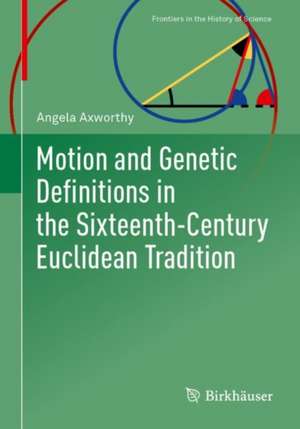Motion and Genetic Definitions in the Sixteenth-Century Euclidean Tradition: Frontiers in the History of Science
Autor Angela Axworthyen Limba Engleză Paperback – 12 iun 2022
Preț: 425.20 lei
Nou
Puncte Express: 638
Preț estimativ în valută:
81.36€ • 87.00$ • 67.84£
81.36€ • 87.00$ • 67.84£
Carte tipărită la comandă
Livrare economică 17 aprilie-01 mai
Preluare comenzi: 021 569.72.76
Specificații
ISBN-13: 9783030958169
ISBN-10: 3030958167
Ilustrații: XV, 300 p. 17 illus.
Dimensiuni: 168 x 240 mm
Greutate: 0.51 kg
Ediția:1st ed. 2021
Editura: Springer International Publishing
Colecția Birkhäuser
Seria Frontiers in the History of Science
Locul publicării:Cham, Switzerland
ISBN-10: 3030958167
Ilustrații: XV, 300 p. 17 illus.
Dimensiuni: 168 x 240 mm
Greutate: 0.51 kg
Ediția:1st ed. 2021
Editura: Springer International Publishing
Colecția Birkhäuser
Seria Frontiers in the History of Science
Locul publicării:Cham, Switzerland
Cuprins
1. Introduction.- 2. Oronce Fine.- 3. Jacques Peletier.- 4. François de Foix-Candale.- 5. Henry Billingsley.- 6. John Dee.- 7. Federico Commandino.- 8. Christoph Clavius.- 9. Synthesis: Continuities and Transformations in the Status of Geometrical Motion and Genetic Definitions from Fine to Clavius.- 10. Later Developments in the Seventeenth Century: a Cartesian Epilogue.
Recenzii
“Axworthy's book fills a gap in the history of the understanding of Euclid's Elements by showing how various commentators have understood the use of kinematic concepts in Euclidean geometry. She concludes her work by showing how the ideas of these commentators contributed to the further acceptance of kinematic approaches to geometry in the work of Descartes and others in the following century.” (Victor J. Katz, Mathematical Reviews, November, 2023)
Textul de pe ultima copertă
A significant number of works have set forth, over the past decades, the emphasis laid by seventeenth-century mathematicians and philosophers on motion and kinematic notions in geometry. These works demonstrated the crucial role attributed in this context to genetic definitions, which state the mode of generation of geometrical objects instead of their essential properties. While the growing importance of genetic definitions in sixteenth-century commentaries on Euclid’s Elements has been underlined, the place, uses and status of motion in this geometrical tradition has however never been thoroughly and comprehensively studied. This book therefore undertakes to fill a gap in the history of early modern geometry and philosophy of mathematics by investigating the different treatments of motion and genetic definitions by seven major sixteenth-century commentators on Euclid’s Elements, from Oronce Fine (1494–1555) to Christoph Clavius (1538–1612), including Jacques Peletier (1517–1582), John Dee (1527–1608/1609) and Henry Billingsley (d. 1606), among others. By investigating the ontological and epistemological conceptions underlying the introduction and uses of kinematic notions in their interpretation of Euclidean geometry, this study displays the richness of the conceptual framework, philosophical and mathematical, inherent to the sixteenth-century Euclidean tradition and shows how it contributed to a more generalised acceptance and promotion of kinematic approaches to geometry in the early modern period.
Caracteristici
Contains the conceptions and treatment of genetic definitions in the 16th century Euclidean tradition Tackles the status and uses of motion in pre- and early modern geometry Provides insight into the mathematical practices of leading 16th century commentators of Euclid’s Elements




